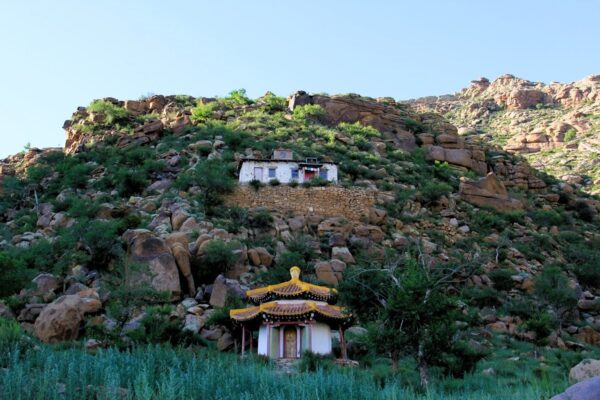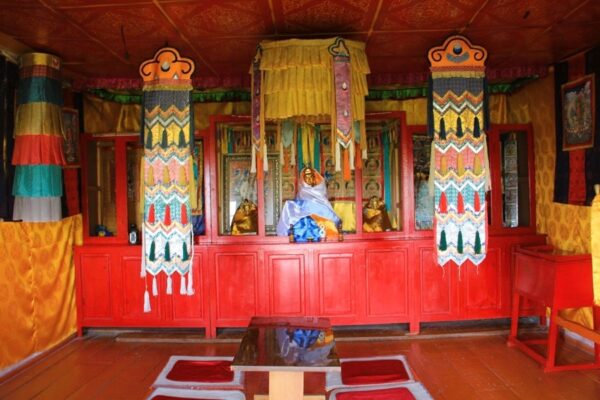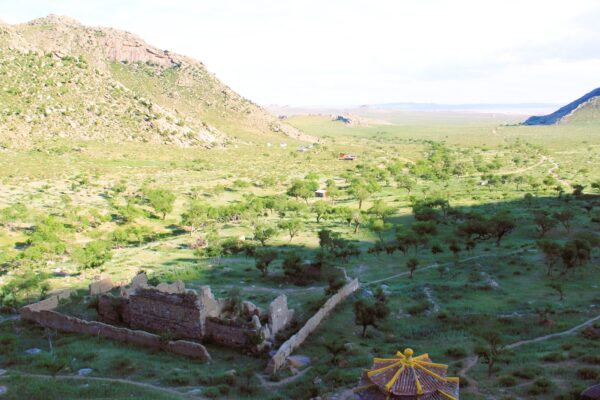The Erdene Khamba Monastery is situated on the southern slope of Khognukhan Mountain, the Khognukhan Old and Young Monastery is a significant historical site. It is located in a picturesque valley that faces southwest and is surrounded by hidden rocky mountains. This area is notable for its spring water, which is accessible only from the southwest. Among the rocks, there are springs believed to be beneficial for various organs, including the stomach, liver, gallbladder, kidneys, and eyes.
Founder of the Monastery
The monastery was built in 1640 by the monk Lhalambaldorj, who fled Tibet after defeating the Tibetan king Lhandarma and played a crucial role in reestablishing Buddhism. He developed the temple in the direction of the Red. Later, in 1693, Undur Gegen Zanabazar restored and expanded the monastery, constructing the Old and Young Monastery in honor of his teacher, Erdene Tsorji.
During the Khalkh-Oirat War, many monasteries were destroyed, leading approximately 200 monks to flee north and settle around Lake Baikal. This migration contributed to the spread of Buryat Buddhism. Over 100 monks were killed by Galdan Khan‘s soldiers, but the surviving monks continued their Khural Dharma activities in the ruins of Khar Bukh.
By the early 22nd century, a new monastery was established in the Bishrelt district of Tusheet Khan Aimag, located on the slopes of Jargalant Khairkhan Mountain. This monastery is historically known as the “Upper and Lower Monastery of Khognu Tarna.” By the beginning of the 20th century, it had expanded into four aimags, housing more than 1,000 monks: Puntsaglin, Tegchilen, Sangai, and Toislin.
The Erdenekhamba region became home to a large monastery, which featured a magnificently crafted Tsogchin temple, numerous Jasin temples, a mosque for reading scriptures, and residential quarters for the monks. This monastery circle had two revered incarnations, Erdene Khamba and Khalzan Shiryat. The main symbol of the circle was the Red Mascot, or Jamsran Buddha.
On the 29th day of the midsummer month, a tsam performance took place, and during the last month of summer, 50 to 60 gelen lamas conducted a 45-day Khailan Khural. Today, the site where the tsam was performed remains part of the Erdene Khamba circle.
Political Repression
In 1937, after more than 30 high-ranking lamas were arrested, the architectural works of the temple, along with precious scriptures and the main idol known as the Red Scepter, were destroyed. When the temple grounds were rebuilt, a special area was paved with colorful stones, centered around the entrance to the main Tsogchin temple. Additionally, a circular area about a meter wide was paved with stones to outline the temple. Within this circular area, there are 29 sections paved with red, blue, and light-colored stones.
Currently, only the stone, mud, and brick walls, temple grounds, stupas, and remnants of the drum remain from the Erdene Khamba Monastery. During the reign of the 13th Bogd Gegeen, the monastery was led by Erdene Khutaght Khamba. When the 13th Dalai Lama returned from his winter stay in Mongolia, he sent a secret envoy to Erdene Khutaght. The edict brought by the envoy stated, “The Supreme Being has come and returned. Erdenekhutagt, you must know that the virtues of Mongolia will be preserved, as they may follow the saint above.” This decree reflects the monastery’s significance at that time.
Restoration
Erdene Khamba Monastery (also known as Khognu Tarnyn Monastery) was restored in 1992 by a nun named Davaa, who continued to participate in the Khural. Davaa is now over 90 years old, but she successfully restored the Tavan Khaan Temple and the amulet temple of Erdene Khamba Monastery, and she built two meditation pavilions and two stupas.
Uvgun Temple (Old Temple)
From Erdene Khamba Monastery, it is over 1 kilometer up the mountain along a narrow and rugged path that can only be traversed on horseback. The entrance to the monastery faces southwest, appearing as if it has opened its arms to welcome the sun’s rays. As you ascend to the monastery, you will encounter unique rock formations that resemble walls adorned with scriptures.
The Uvgun Temple was constructed similarly to the Potala Palace in Tibet. Today, remnants of more than ten temples can be found, their walls made of carefully stacked stones that ascend the mountainside. There is an old story associated with this monastery: on a mountain balcony, Undur Gegen(Saint) Zanabazar and his disciples established a sacred site known for its golden Ganjir. Here, they held meetings and lectures during the summer months, where ascetic monks would gather as disciples.
Legend of the Uvgun Temple
When the Khalkh-Oirat War broke out, the soldiers of Galdan Boshigt came searching for the Uvgun Temple, home to the monks of the Zanabazar. The monks had hidden the golden ganjir with a scythe, so the soldiers left without finding it. However, an old woman remarked, “The soldiers have returned; now let’s retrieve that ugly scythe.” The soldiers descended from the khairkhan and climbed a nearby mountain. When they spotted the hidden golden ganjir of the Uvgun Temple shining in the morning sun, they returned and found the temple.
They captured and killed about 100 monks, tied them together with ropes, their heads and feet together (this is how the Mongols tie animals), and threw them off a high cliff.







